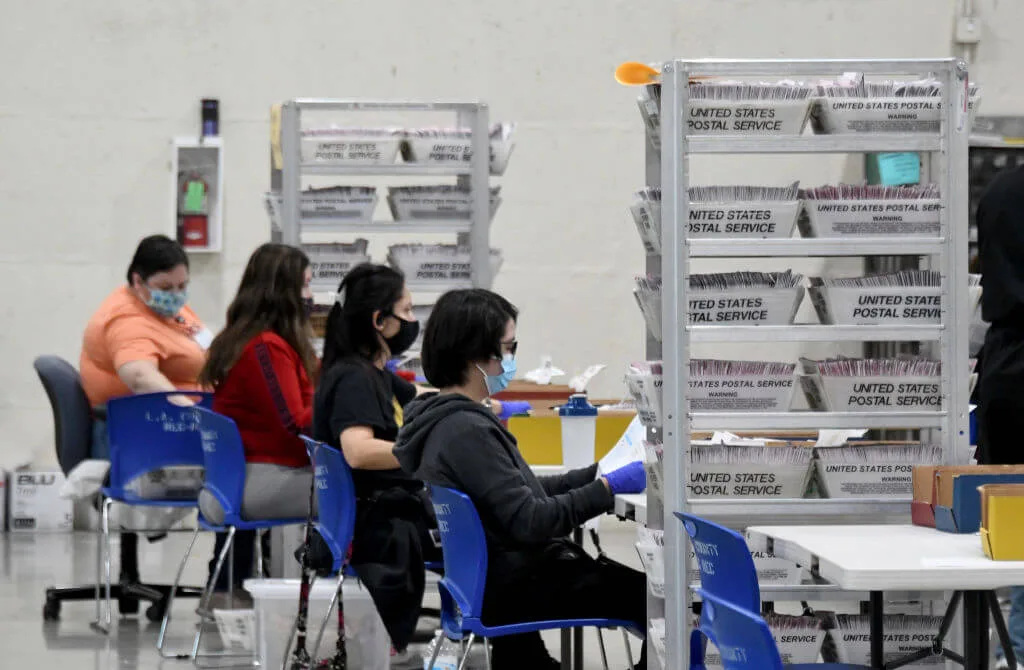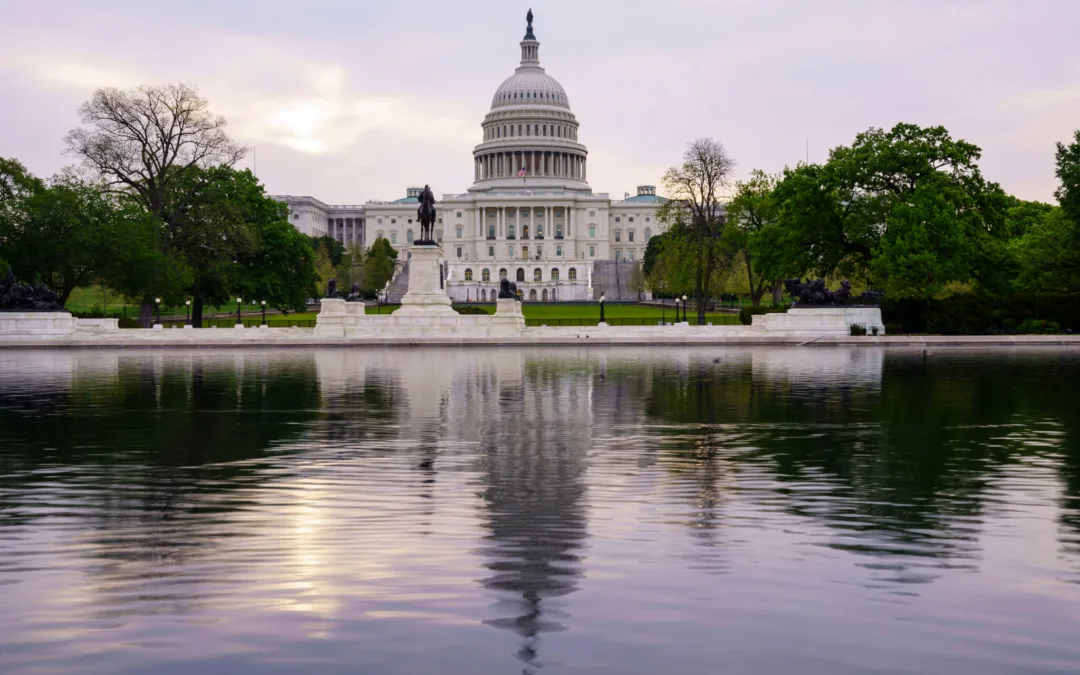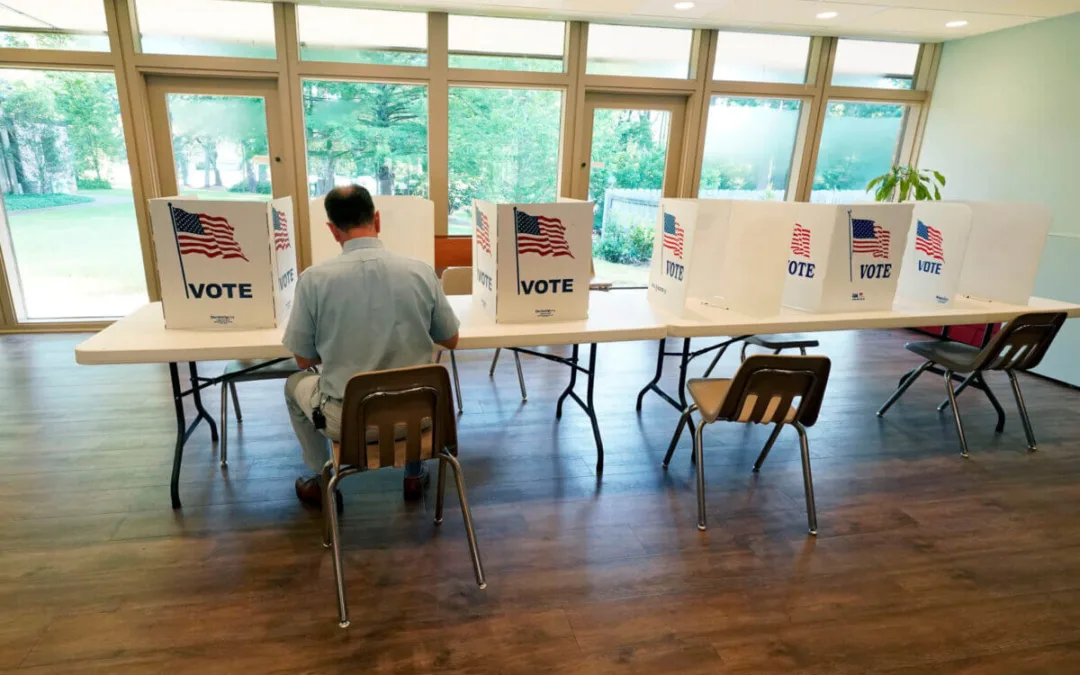
At the ballot processing center at the LA County Registrar temporary building at the Fairplex in Pomona on Friday, October 23, 2020. (Photo by Keith Birmingham/MediaNews Group/Pasadena Star-News via Getty Images)
There is nothing illegal about counting votes after election night—and there never has been. That’s especially true this year, with a surge of mail-in ballots.
As states across the nation count every ballot cast in the 2020 election, Joe Biden has repeatedly issued calls for patience and calm—both during his election night speech from Wilmington, Delaware, and on Twitter.
Biden’s calls to count every ballot are especially crucial in an election that saw over 100 million Americans vote early, with millions sending their ballot through the mail or as absentee ballots due to continuing surges in the coronavirus. During his campaign, President Donald Trump has repeatedly lied about the validity of mail-in voting, despite his own history of voting by mail and overwhelming evidence that voter fraud (including mail-in voting) is less common than being struck by lightning.
He repeated those inaccurate claims on election night and the following day, though was quickly shut down by fellow Republicans and labeled with flags about misinformation on Twitter and Facebook. Trump’s Twitter claims in recent weeks have centered on the historically incorrect assertion that counting ballots should end on Election Day.
READ MORE: Florida Amendments: What Passed and What They Mean For You
In reality, counting all of the votes on Election Day and having final results has never happened in modern history. No state reports final results on election night, and the winner of the presidential election hasn’t been known before midnight in three of the past five elections (2000, 2004, 2016).
Instead, what Americans see when a winner is declared on election night are projections made by news organizations based on partial, unofficial counts. Those estimates are based on the candidate’s lead, number of outstanding ballots, and which specific area of a state those votes are coming from. But these projections are not official results and never have been.
In truth, ballots always arrive and are always counted after Election Day. Whether it’s military ballots from overseas, ballots postmarked by Election Day that arrive after, or provisional ballots cast by voters who had an issue at their polling place, there is nothing nefarious about votes being counted after election night and there never has been. The key difference this year is the surge of mail-in voting amid the coronavirus pandemic, meaning there will be a higher percentage of ballots that cannot be counted on election night.
More than 60 million Americans have already voted by mail. Many states, including the key swing states of Pennsylvania and Wisconsin, don’t begin counting the millions of mail-in ballots they’ve received until the morning of Election Day. That means that unless the race is a blowout, like in 2008 when President Obama handily defeated Republican John McCain, the final election result may not be known for days, or possibly weeks.
READ MORE: Pelosi Says She Is Ready to Fight if President Trump Tries to Steal the Election
But that doesn’t mean there’s a problem. Quite the contrary actually. Instead, a delay simply means that democracy is working properly and that election officials are taking their time to ensure that every vote is counted. In fact, in every election, states “canvass” their results after the election to ensure that unofficial results reported on election night were accurate, resolve any issues or errors included in the unofficial results, and to guarantee that any outstanding ballots that are deemed eligible to count do count.
Despite this reality, Trump has made clear that instead of promoting a free and fair election, he intends to challenge ballots that are counted after Tuesday evening. Axios reported on Sunday that Trump has told allies he will declare victory on election night if it looks like he is “ahead,” even if final results remain outstanding.
“I think it’s terrible that we can’t know the results of an election the night of the election,” Trump told reporters Sunday. “We’re going to go in the night of, as soon as that election’s over, we’re going in with our lawyers.”
Trump advisor Jason Miller echoed the president’s comments on Sunday, saying on ABC’s This Week that he believes Trump will be ahead on election night, but that Democrats would try to “steal it back after the election.”
The Trump campaign’s anti-democracy rhetoric is so extreme that many Republicans have since spoken out against it. Utah Lieutenant Governor Spencer Cox, who oversees the state’s mostly-mail election system and is currently the Republican nominee for governor, called Miller’s comments “garbage” in a long tweet thread laying out how the counting process works.
Ohio Republican Secretary of State Frank LaRose also refuted Trump’s claim that the election count would end on Tuesday, telling CNN “That’s not the way elections work. It’s just simply not. It’s not the way elections work in Ohio or most any other state. Election night is a snapshot in time.”
Benjamin Ginsberg, who was one of the Republican Party’s lead election attorneys for nearly 40 years, called Trump’s effort as “un-American as it gets.”
“President Trump has failed the test of leadership. His bid for reelection is foundering,” Ginsburg wrote in a Washington Post op-ed on Sunday. “And his only solution has been to launch an all-out, multimillion-dollar effort to disenfranchise voters—first by seeking to block state laws to ease voting during the pandemic, and now, in the final stages of the campaign, by challenging the ballots of individual voters unlikely to support him.”
As Ginsberg noted, Trump’s rhetoric is just the latest part of a concerted strategy to sow doubt around the validity of mail-in ballots and in turn, the results of the election—which virtually every poll and analysis shows him losing. As states rushed to expand mail-in voting to accommodate citizens afraid of voting in-person amid the coronavirus pandemic, Trump repeatedly attacked mail-in ballots as being rife with fraud, even as study after study has debunked that lie.
“Nearly every Election Day since 1984 I’ve worked with Republican poll watchers, observers and lawyers to record and litigate any fraud or election irregularities discovered,” Ginsberg wrote. “The truth is that over all those years Republicans found only isolated incidents of fraud. Proof of systematic fraud has become the Loch Ness Monster of the Republican Party. People have spent a lot of time looking for it, but it doesn’t exist.”
Trump’s attacks on mail-in ballots have had huge consequences though, creating an enormous partisan split in who is voting by mail. Democrats have embraced voting by mail and requested millions more ballots than Republican voters, who thanks to Trump, are skeptical of mail-in ballots and are far more likely to vote in person on Election Day. Since mail-in votes will lean heavily Democratic, take longer to count, and in many states can’t be counted until Election Day, it’s likely that as in-person, Election Day votes are counted on Tuesday, Trump will hold a lead over Biden. But this “red mirage” will be temporary and not indicative of the final result, which will only be known once mail-in ballots are verified and counted.
This sort of “blue shift” has happened in recent elections. In 2018 for example, Republican Martha McSally led the Democrat Kyrsten Sinema by 1% in the Arizona Senate race on election night. But after the final 600,000 votes were counted the next day, Sinema won by nearly 3%.
That reality may not stop Trump from preemptively declaring victory and challenging the counting of millions of legitimate votes. The president specifically cited Pennsylvania on Sunday—which is widely viewed as the state most likely to decide the election—as being a state in which he would challenge the validity of mail-in ballots tabulated after Election Day, even though it was the Republican legislature in that state that refused to allow counties to begin processing ballots prior to Nov. 3 in order to speed up the count. As a result, state election officials have said that it could take until Friday to finish counting most ballots.
“I expect that the overwhelming majority of ballots in Pennsylvania, that’s mail-in and absentee ballots, as well as in-person ballots, will be counted within a matter of days,” Pennsylvania Secretary of State Kathy Boockvar said on NBC’s “Meet the Press.”
Trump’s desire to file such a challenge in the state stems from the fact that he is likely to hold a substantial lead in Pennsylvania on Tuesday evening. More than 2.2 million mail-in ballots have already been returned in the state, and polls suggest Biden could win around 75% of these ballots. The split could be so severe in Pennsylvania, according to election prognostications site FiveThirtyEight, that Trump could appear to hold a 16-point lead (58% to 42%) on Election Night, based on about 60% of the expected vote. But as the millions of mail-in votes are counted in the next few days, Biden would surge and take a lead, undoing this “red mirage” with a blue shift.
Such a shift is similarly likely to occur in states like Michigan and Wisconsin, but there’s also the possibility of a “red shift” in states like Florida and North Carolina, which have counted mail-in ballots as they arrive. Texas, Ohio, and Iowa could also see changes, as they quickly publish unofficial results from pre-Election Day voting—which are likely to favor Biden—before Election Day results, which are likely to help Trump.
There is also the possibility that we will know who wins on Tuesday night. The vast majority of votes are likely to be known in competitive states like Arizona, North Carolina, Georgia, Florida, and Texas, and if Biden is far ahead in those races—especially in Florida or Texas—it could be a harbinger for a Biden blowout.
But that is not the most likely scenario. Instead, voters should prepare to have to wait for results, regardless of what President Trump or his campaign says and does on Tuesday and in the days following. With as many as 150 million voters expected to cast a ballot this year, election officials are working overtime to make sure every vote counts and the US has a free and fair election.
Rather than embrace or promote those efforts, Trump and his allies have made clear they intend to actively fight against the very idea of democracy by perpetuating the myth of voter fraud.
“As he confronts losing, Trump has devoted his campaign and the Republican Party to this myth of voter fraud. Absent being able to articulate a cogent plan for a second term or find an attack against Joe Biden that will stick, disenfranchising enough voters has become key to his reelection strategy,” Ginsberg wrote. “This is not about finding fraud and irregularities. It’s about suppressing the number of votes not cast for Trump.”
Politics

Teamsters and UPS Reach Tentative Deal to Avoid Strike, 340,000 Workers to Get Raises
The tentative deal represents a huge win for full- and part-time UPS Teamster workers, who would get significant pay raises and better working...



One Republican Senator Is Blocking 265 Military Promotions, Leaving the Marines Without a Confirmed Leader
Sen. Tommy Tuberville's decision means these military officers are not getting the pay raises they’re owed, cannot move their families to wherever...
Local News



Teamsters and UPS Reach Tentative Deal to Avoid Strike, 340,000 Workers to Get Raises
The tentative deal represents a huge win for full- and part-time UPS Teamster workers, who would get significant pay raises and better working...



One Republican Senator Is Blocking 265 Military Promotions, Leaving the Marines Without a Confirmed Leader
Sen. Tommy Tuberville's decision means these military officers are not getting the pay raises they’re owed, cannot move their families to wherever...




